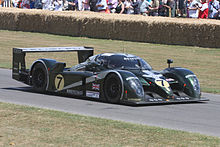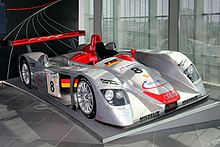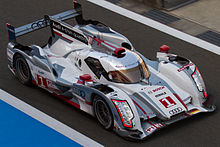Le Mans prototype
A Le Mans Prototype (short: LMP ) is a specially designed for automobile racing, especially for sports car races like the 24-hour race at Le Mans , the United SportsCar Championship , European Le Mans Series and the World Endurance Championship , custom-built prototype . Created by the Automobile Club de l'Ouest (ACO), they are the fastest racing cars with closed wheel arches that are used in circuit races today. They are in a class above the series-based GT cars. Their costs and technology make them comparable to Formula 1 vehicles .
Although they are commonly known as Le Mans prototypes, different names have been used for this type of vehicle, depending on the racing series. Since 2004 they have been referred to as Le Mans prototypes (LMP) in all classes .
history


The first impression of what Le Mans prototypes would one day was given at the 24 Hours of Le Mans in 1992. In an effort to increase the number of participants beyond the small category of Group C cars, the older Porsche 962 approved for category 3. In addition, smaller racing cars with an open cockpit and normal street engines, such as those used in smaller, national racing series, were approved in Category 4. Only three vehicles were registered, all of which failed due to defects.
In the end, both the World Sportscar Championship and the All Japan Sports Prototype Championship ended , leaving the expensive Group C prototype little room for competition outside of the 24 Hours of Le Mans.
With the phasing out of Group C, the ACO allowed close-to-production racing cars to be used again for the first time in many years.
1994 to 1999: LMP1, LMP2 & LMPGT
In 1993 the Automobile Club de l'Ouest developed a new set of regulations to replace Group C : the Le Mans Prototype Class (LMP) and the GT1 class. First the specially developed, large-displacement LMP1, which is normally equipped with turbochargers, and the LMP2, which used smaller, near-series engines. The GT1 class was actually reserved for near-series vehicles, the racing cars had to have a counterpart on the road, LMP prototypes were not affected by this rule. The ACO also announced that the Le Mans prototypes would replace the Group C cars by 1994.
After 1999, new regulations came into force. The previous GT1 class was abolished and the LMGTP class was created to replace it. No more road vehicles had to be built for this prototype GT class.
2000 to 2004: LMP900 & LMP675 regulations
In 2000 new regulations were created for two prototype classes: the "LMP900" and the "LMP675" class. Both names are based on the minimum weight of the respective class. The prototypes were allowed to be a maximum of 4650 mm long, 1020 mm high and 2000 mm wide. The LMP900 vehicles were allowed to use engines up to 6000 cm³ for normal gasoline engines and 4000 cm³ for turbocharged engines, the number of cylinders was not limited. Vehicles of the LMP675 class were allowed to install a maximum of 8 cylinders with 3400 cm³ displacement for normal gasoline engines or a maximum of 6 cylinders with 2000 cm³ displacement for turbocharged engines.

Both classes were open to both private manufacturers and factories. During this time Audi , Chrysler , Cadillac & Panoz developed vehicles according to the LMP900 regulations while MG built a vehicle according to the LMP675 regulations.
2005 to 2013: New LMP1 & LMP2 regulations
In 2004, the Automobile Club de l'Ouest began restructuring the two overall victorious prototype classes LMP900 and LMP675 into a hierarchical structure with faster LMP1s for factory and more professional private teams and more cost-effective LMP2s. The regulations came into force in 2005, and all older prototypes were allowed to continue to run as so-called 'hybrids' with modifications until 2006.
In 2009 the ACO introduced a number of modifications to both the technical regulations. From 2009 LMP1 Le Mans prototypes with energy recovery systems were allowed to take part in the championship
From 2011, all LMP vehicles had to have a fin on the rear to prevent the prototype from rolling over.
2014 to date: LMP1 hybrids, inexpensive LMP2 and new LMP3 regulations
The Automobile Club de l'Ouest and the FIA began working on the LMP1 regulations for 2014 in 2012. The LMP1 class is divided into two categories: LMP1-H and LMP1-L. The abbreviation "H" after the name stands for hybrid and the abbreviation "L" for lightweight construction. In the LMP1-H category, manufacturers are now obliged to start with KERS prototypes. Private teams, on the other hand, are only allowed to participate in the LMP1-L class without hybrid. Only closed vehicles are allowed to participate in both categories.
The various hybrid and motor systems are adjusted by means of a so-called Equivalence of Technology in order to ensure equal opportunities. The adjustment takes place via the amount of energy available per lap from the hybrid and mechanical motor.
In 2014, the LMP3 class was also announced. This class is intended as a low-cost entry into long-distance and prototype sports. In order to keep costs under control, only certified manufacturers are allowed to build LMP3 vehicles, and there is an upper cost limit for a ready-to-drive chassis.
For safety reasons, only vehicles with a closed cockpit will be permitted in the LMP2 class from 2016. In order to avoid a technical arms race in the LMP2 class, from 2017 only manufacturers certified by the Automobile Club de l'Ouest will be allowed to participate. Many components have also been standardized in order to keep costs under control, such as a standard engine and standard electronics or an upper cost limit for a vehicle that is ready to drive.
Vehicle types
A distinction is made between open Le Mans Roadsters (LMR) and closed Le Mans prototypes (LMP). Both vehicle types can be used in both performance classes, e.g. B. LMR1 or LMR2, are homologated . Closed vehicles must have a windshield, a roof and a door on each side, i.e. a closed cockpit . Although a passenger seat does not have to be installed, the minimum cockpit size is set so that there is space for a passenger next to the driver. The resulting free area in the cockpit is mostly used for cooling, radio, fire extinguishers and other elements. The open area plays an important role in the roadster because the releasing driver often remains in the cockpit “on the passenger side” in order to help the changing driver with buckling up etc.
LMP1
LMP1 vehicles use innovative technologies such as various types of energy recovery systems. The regulations allow a free choice of concepts such as front, mid or rear engines, front or standard drive, gasoline or diesel engines as well as naturally aspirated or turbo engines. Hybrid systems are allowed and can be used, for example, to provide a temporary all-wheel drive.
In the LMP1 class, manufacturers have to install a hybrid system, but private teams are not allowed to do so. LMP1 vehicles are only eligible to participate in the FIA World Endurance Championship .
Technical regulations
The main rules of the Technical Regulations (as of 2017) are listed below:
| LMP1-H (works teams) | LMP1 (private teams) | |
|---|---|---|
| Minimum weight | 878 kg | 833 kg |
| length | Max. 4650 mm | |
| height | Max. 1050 mm | |
| width | 1800 - 1900 mm | |
| Internal combustion engine | Otto - or diesel - four stroke - piston engine | |
| Displacement | not limited | 5,500 cm³ |
| Number of cylinders | not limited | |
| Charging | up to 4 bar | |
| Energy recovery | Max. 2 energy recovery systems | No |
| tank | 62.3 l petrol or 50.1 l diesel | 75 liters of petrol |
| Tire diameter | Max. 28 ″ | |
| Tire width | Max. 14 ″ | |
Others
- LMP1: The max. Fuel flow rate and fuel energy per lap are limited. For the LMP1-H vehicles, it must be specified how much energy is to be recovered per lap (2-, 4-, 6- or 8-MJ class).
- Biofuels are allowed in both classes.
- The body must cover all mechanical parts so that they cannot be seen directly from the front, above or from the side.
LMP2

The LMP2 class is located below the LMP1 and above the LMP3 class. In the past, open and closed vehicles were allowed to drive in the LMP2 class; for safety reasons, only closed cockpits will be allowed from 2016.
Because vehicles of the LMP1 class are only allowed to take part in the FIA World Endurance Championship, the LMP2 class represents the top class in many racing series. From 2017, only vehicles from Automobile Club de l'Ouest certified manufacturers are permitted.
The following manufacturers and vehicles are currently certified:
-
 Dallara : P217
Dallara : P217
-
 Ligier : JS P217
Ligier : JS P217
-
 Oreca : 07
Oreca : 07
-
 Riley Multimatic : Mk.30 LMP2
Riley Multimatic : Mk.30 LMP2
Technical regulations
The vehicles have a closed cockpit and use a V8 standard engine with a displacement of 4,200 cm³ from Gibson Technology . Unit electronics from Cosworth are used. A race-ready chassis cannot cost more than € 483,000. In addition, each driver pairing must have at least one amateur driver (Silver or Bronze license class).
| Empty weight: | 990 kg |
| Length: | 4750 mm |
| Width: | 1900 mm |
| Tank capacity: | 75 L petrol |
LMP3
The LMP3 class is intended as an entry-level class in long-distance sports. The racing class was announced by the Automobile Club de l'Ouest in 2014 , and races have been held with these vehicles since 2015. The vehicles have standardized parts: the transmission comes from X-Trac and the vehicle electronics from Magneti Marelli .
Only manufacturers certified by the Automobile Club de l'Ouest are allowed to produce LMP3 class vehicles.
The following manufacturers and vehicles are currently certified:
-
 Adess : Adess 03
Adess : Adess 03
-
 Ave-Riley : AR2 LMP3
Ave-Riley : AR2 LMP3
-
 Dome : TBA
Dome : TBA -
 Ginetta : Juno LMP3
Ginetta : Juno LMP3
-
 Ligier : JS P3
Ligier : JS P3
-
 Norma : M30 LMP3
Norma : M30 LMP3
Technical regulations
The vehicles have a closed cockpit and use a standard Nissan V8 engine . A race-ready chassis cannot cost more than € 206,000.
| Empty weight: | 900 kg |
| Length: | 4650 mm |
| Width: | 1900 mm |
| Tank capacity: | 100 L petrol |
See also
Individual evidence
- ↑ Technical regulations for the LMP900 & LMP675 class in 2001
- ↑ New classification of the Equivalence of Technology
- ^ Classes - FIA World Endurance Championship. Retrieved May 3, 2017 (French).
- ↑ Technical regulations of the LMP2 class
- ↑ Announcement of the LMP3 class
- ↑ Technical regulations of the LMP3 class



